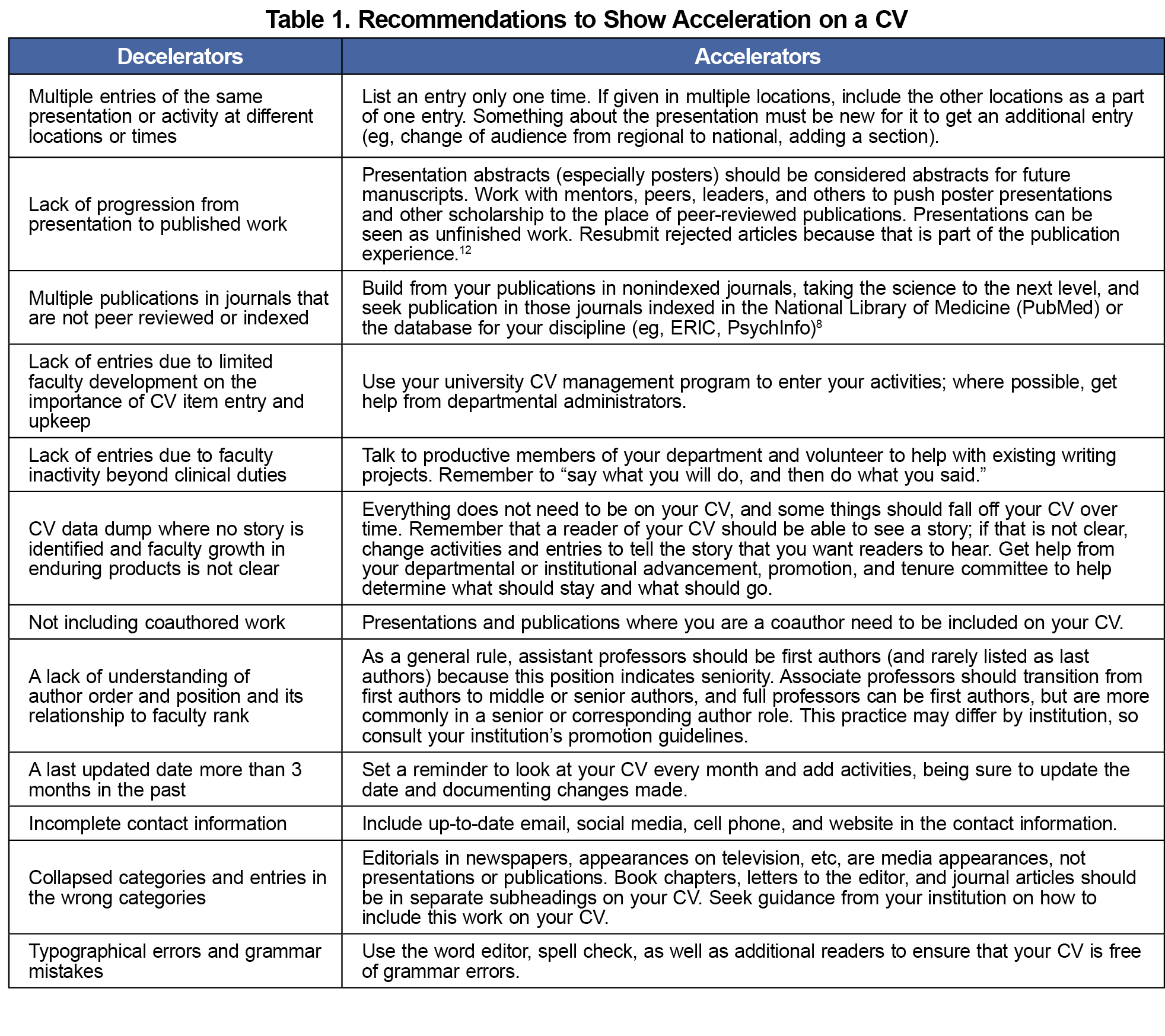The curriculum vitae (CV) is one of the most important documents a faculty member can create. It catalogs the training history, accomplishments, awards, and productivity of a faculty member over time and is used by advancement, promotion, and tenure committees to determine whether a faculty member has earned promotion and tenure. Prior work has demonstrated how medical students and faculty should build their CVs,1-4 but scant literature speaks to how CVs can become useful or limiting for faculty, regardless of whether a faculty member is actively going through the promotion process. On the Association of American Medical Colleges website, technical tips about organizing content on a CV are listed, but the site does not share how a CV is viewed or considered by peers or evaluators.5,6 Faculty may not recognize a powerful CV nor know how to create one. They also may have inadvertently created a CV that shows deceleration or slowed progress toward advancement, which can impact the ability to achieve promotion.
PROFESSIONAL DEVELOPMENT PERSPECTIVE
Gearing Up: Accelerating Your CV to Promotion and Tenure
Kendall M. Campbell, MD | José E. Rodríguez, MD, FAAFP
PRiMER. 2024;8:1.
Published: 1/10/2024 | DOI: 10.22454/PRiMER.2024.782013
The curriculum vitae (CV) is an important document for a faculty member and is one of the first documents reviewed by peers or evaluators when a faculty member is being considered for promotion. It catalogs the training history, accomplishments, awards, and productivity of a faculty member over time. Prior work has demonstrated how the CV should be organized and what content should be included. However, no contributions to the literature have discussed how reviewers and other academic leaders view CVs, how to structure CV entries to promote career advancement, and how CVs can become useful or limiting for faculty, regardless of whether a faculty member is actively going through the promotion process. We discuss how the CV can be seen by evaluators and concerns that can cause the CV to decelerate. We then make recommendations on how the CV can accelerate a faculty member toward academic career advancement and promotion.
In working with early career family medicine faculty, we have reviewed many CVs and have noted many challenges. For example, some CVs are very thin, where the time in rank of a faculty member should have resulted in more entries across the domains of education, research, and clinical care. At times this is due to not recording accomplishments, but at other times it is due to increased focus on clinical care or other pursuits consuming any time available for scholarly projects and CV building, especially for underrepresented minority faculty and women of all races.7,8 However, many faculty may not have had faculty development regarding the importance of CV entry and upkeep, and may not have been afforded opportunities for accomplishments to add to the CV. The major problem with decelerated or stagnant CVs is that they do not tell the story of faculty growth and progress. An example would be multiple entries of the same presentation at different locations on the CV, causing the CV to cease telling a narrative about career progress. Decelerated CVs are a problem that is not unique to family medicine faculty.6 While the literature offers structural and content-based tips on how to build CVs and on what to include on a CV, it lacks details on how a CV creates a narrative and the importance of narrative for career advancement.9
A CV requires careful planning; it is both a record of work and a narrative about a faculty member’s career.6 It should be easily accessible and shareable with peers and colleagues.
This paper builds on the published literature on CVs and the available information on CV creation from multiple websites. We developed this manuscript to help faculty move beyond the CV being solely a record or data dump of career activities and create in their CV a narrative that leads to career advancement. An accelerated CV serves the faculty member; it tells the story of why the faculty member is qualified for advancement or other activities.
Tools to accelerate CVs are available from multiple sources: local mentors, recently promoted peers in other specialties, external mentors within family medicine professional organizations, national fellowships,10,11 Society of Teachers of Family Medicine (STFM) annual conferences, and the STFM Resource Library. We offer the suggestions in Table 1 to accelerate a CV toward academic promotion and tenure.
In this manuscript we have discussed the accelerators and decelerators toward promotion and tenure in academic medicine as evidenced in the CV. Specifically, the CV is a story, and faculty can use the table to ensure that their story is accurately reflected in their CV. Leaders who read CVs are looking for progression and for a cohesive thread throughout; faculty should have that in mind when modifying their CV. Key accelerators include transitioning presentations to publications, keeping the CV updated, and avoiding redundancies wherever possible. Mentorship can play a vital role in crafting a CV and in purposefully creating a cohesive narrative of teaching expertise, leadership, and scholarship. The information in this manuscript can serve to help increase the number of family medicine faculty who have CVs that are competitive for promotion as well as help grow faculty’s scientific, education, and service contributions.
Acknowledgments
The authors acknowledge the Society of Teachers of Family Medicine and the American Board of Family Medicine Foundation for their ongoing support of the Leadership Through Scholarship Fellowship through which this work has been made possible. The authors also thank Christen Walcher, MPAff, research development specialist for the Department of Family Medicine at the University of Texas Medical Branch for her assistance with formatting this manuscript in preparation for submission.
References
- Gc S, Shrestha R. Building curriculum vitae as a medical student. JNMA J Nepal Med Assoc. 2023;61(258):192-194. doi:10.31729/jnma.8019
- Oxtoby K. Tips on preparing your medical CV. BMJ. 2019;366:l4875. doi:10.1136/bmj.l4875
- Lin S, Gordon P. Preparing residents for teaching careers: the faculty for tomorrow resident workshop. Fam Med. 2017;49(3):225-229. https://www.stfm.org/familymedicine/vol49issue3/Lin225
- Keating MK, Pasarica M, Stephens MB, et al. Promotion preparation tips for academic family medicine educators. Fam Med. 2022;54(5):369-375. doi:10.22454/FamMed.2022.414574
- Association of American Medical Colleges. Curriculum vitae—tips and strategies. Accessed June 23, 2023. https://www.aamc.org/career-development/affinity-groups/group-faculty-affairs/faculty-vitae/curriculum-vitae-tips-and-strategies
- Hobson WL, Gordon RJ, Cabaniss DL, Richards BF. Documenting educational impact in the promotion dossier with an enhanced curriculum vitae. J Contin Educ Health Prof. 2022;42(1):47-52. doi:10.1097/CEH.0000000000000386
- Arora VM, Wray CM, O’Glasser AY, Shapiro M, Jain S. Using the curriculum vitae to promote gender equity during the COVID-19 pandemic. Proc Natl Acad Sci USA. 2020;117(39):24032. doi:10.1073/pnas.2012969117
- Rodríguez JE, Campbell KM, Patterson B. Research and scholarship. In: Sánchez JP, ed. Succeeding in Academic Medicine. Springer; 2020. doi:10.1007/978-3-030-33267-9_6
- Office for Faculty Affairs. Crafting your faculty of medicine CV. Harvard Medical School. Accessed June 23, 2023. https://www.massgeneral.org/assets/mgh/pdf/faculty-development/career-advancement-resources/promotion-cv/crafting_your_faculty_of_medicine_cv.pdf
- Robles J, Anim T, Wusu MH, et al. An approach to faculty development for underrepresented minorities in medicine. South Med J. 2021;114(9):579-582. doi:10.14423/SMJ.0000000000001290
- Rodríguez JE, Campbell KM, Pololi LH. Addressing disparities in academic medicine: what of the minority tax? BMC Med Educ. 2015;15(1):6. doi:10.1186/s12909-015-0290-9
- Campbell KM, Washington JC, Baluchi D, Rodríguez JE. Submit it again! learning from rejected manuscripts. PRiMER. 2022;6:42. doi:10.22454/PRiMER.2022.715584
Lead Author
Kendall M. Campbell, MD
Affiliations: Department of Family Medicine, University of Texas Medical Branch, Galveston, TX
Co-Authors
José E. Rodríguez, MD, FAAFP - University of Utah Health Equity, Diversity and Inclusion, Salt Lake City, UT
Corresponding Author
Kendall M. Campbell, MD
Correspondence: The University of Texas Medical Branch, Galveston, TX
Email: kemcampb@utmb.edu
Fetching other articles... 
Loading the comment form... 
Submitting your comment... 



There are no comments for this article.